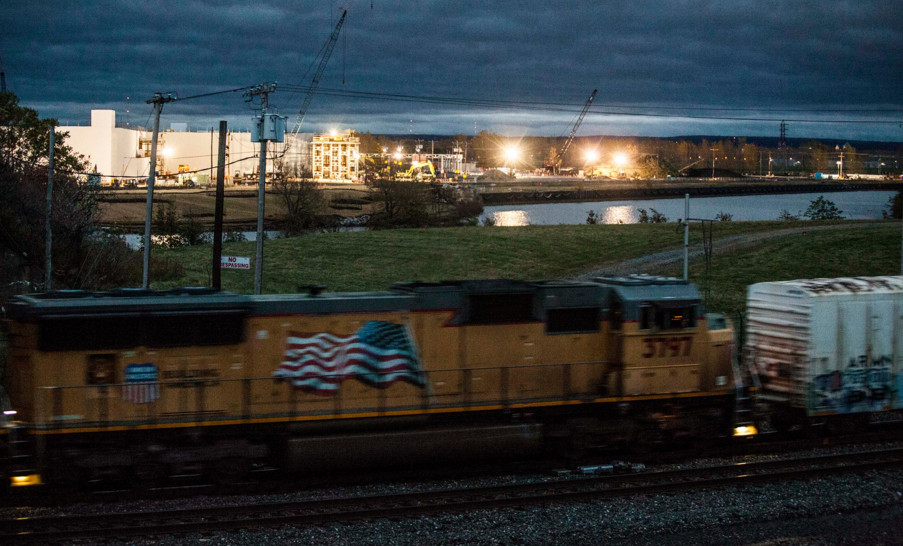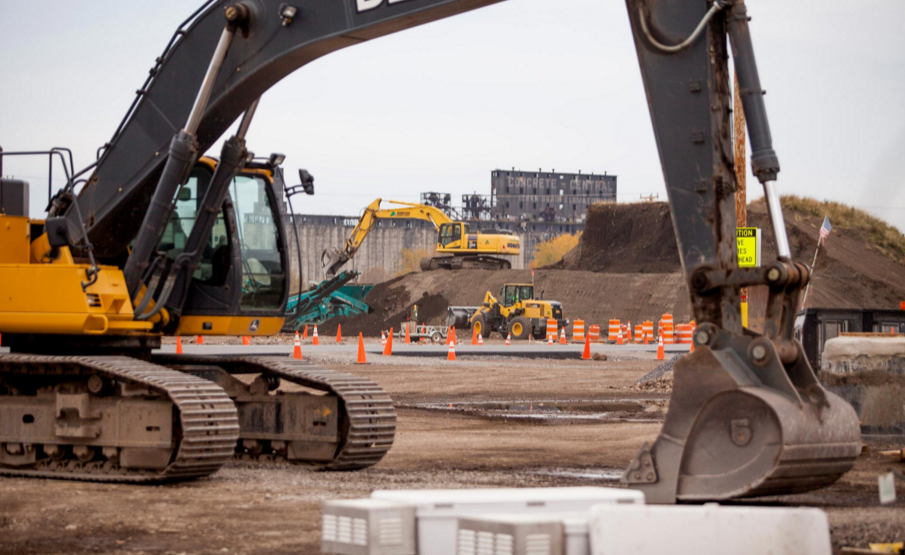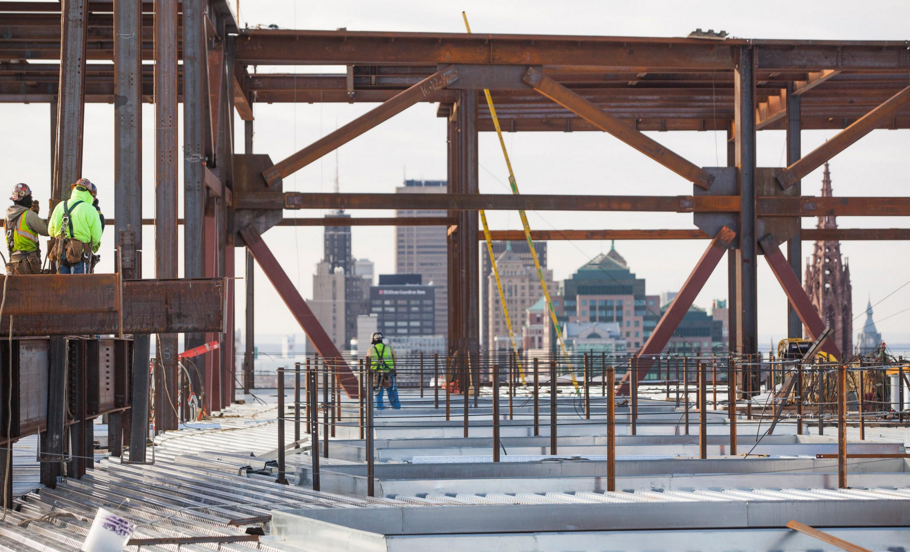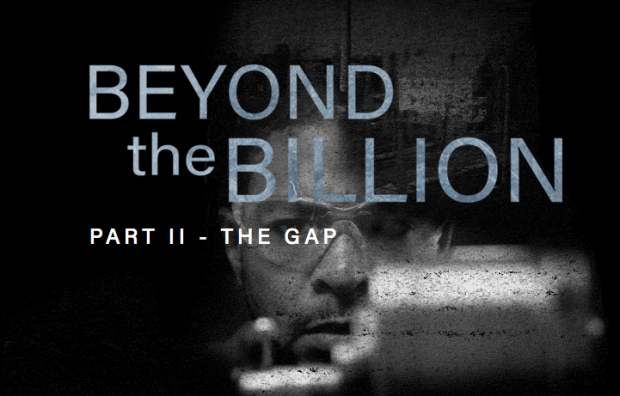Beyond the Billion, Part II
The following is part II of a series focusing on the underside of the “Buffalo Billion” that appears courtesy of a content-sharing agreement with City & State.
Story by Justin Sondel, photos by Brendan Bannon.
Tuan Jones stands next to a humming lathe, staring intently from behind protective glasses as small shards of metal are stripped from the cylinder he is working on and fall into the tray below or out onto the shop floor.
It’s mid-February, and Jones and his classmates are about three-quarters of the way through a yearlong training program that will certify them to work as machine technicians at one of the many shops throughout the area that are starved for qualified workers.
To qualify, a prospective trainee must have been out of work for 20 weeks. They are in the classroom and the machine shop five days a week, eight hours a day.
Jones, who returned to Buffalo several years ago after spending 14 years in the Navy, came across the opportunity through a state Department of Labor email. After having little success in the job market, despite his extensive experience as an air conditioning and refrigeration specialist, he decided to enroll in the program.
In Jones’ estimation, his lack of connections to people in the trades was one reason he was finding it so hard to get decent work. Considering Buffalo’s recent construction boom, he thought there would be plenty of opportunities for someone with heating and cooling systems know-how.
“It’s not what you know,” Jones said. “It’s who you know.”
Out of work for months, Tuan Jones enrolled in an advanced manufacturing training program at Buffalo State College.
MIND THE GAP
When the participants graduate in May, the numbers would suggest that finding a job will be easy. Manufacturers have complained of a dearth of skilled workers capable of running the sort of computerized numerical control machines used today. While the Department of Labor projects that manufacturing jobs in the region will fall by about 2 percent from 2012 to 2022, some subgroups are expected to grow. Jobs in fabricated metal product manufacturing are expected to rise by 9 percent in the region, while other sectors, including the manufacturing of furniture, wood products and primary metals, are also expected to grow.
And those numbers, calculated before Gov. Andrew Cuomo’s Buffalo Billion announcement, are conservatively based in historical data. None of the initiatives introduced since then—Buffalo Manufacturing Works, the Riverbend solar panel manufacturing plant—factor in.
SolarCity, which will make solar panels at the state-owned and built factory at Riverbend, is alone expected to create nearly 3,000 jobs in the region, many of them in the sort of work Tuan and his classmates are training for. In addition, a large swath of the manufacturing workforce is nearing retirement age. Industry estimates suggest that around 17,000 jobs in the sector will open up due to retirement or job growth by 2020.
Those opportunities are already starting to come around, said professor Steve Macho, one of the Buffalo State teachers running the advanced manufacturing program.
“Companies like MOOG, Ford, the GM plant, PCB, they all do a great deal of machining, and their workforce has been in place for 25 to 30 years,” Macho said while sitting in a hallway outside of one of the shops where the participants were working this fall. “They’re highly skilled, they earn very good checks and they’re about to retire.”
For decades, manufacturing has been moving in the opposite direction. As jobs became more scarce, the mostly white workforce often encouraged family members to get into the same line of work, Macho said.
Macho, who has been working at Buffalo State for a decade and has had active relationships with many of the region’s manufacturing companies throughout that time, said he cannot recall ever seeing an African-American—and only one woman, maybe two—on a shop floor.
“If you’re a person of color, you’re on the outside,” Macho said. “You don’t have any cousins or brothers or uncles in that industry.”
The free training program, which launched last year, is funded by more than $400,000 in grants from the state Department of Labor and JPMorgan Chase, enough to run through 2017. Minorities, women and veterans are given priority, a fact reflected in the makeup of the class: They are mostly people of color, and about a quarter women, many with military service on their resumes.
The program poses some of the same obstacles that can sideline the long-term unemployed, such as a requiring a high school diploma or equivalency certificate. But unlike many similar programs—Alfred State College and Erie Community College both have training programs with pipelines to employers—Buffalo State has an aggressive outreach effort that relies on community organizations and church groups, as well as more traditional means like the labor department, to recruit participants.
“There’s still the inherent social barriers that enforce a very real form of racism. Our program’s intention was to recruit those on the wrong side of the barrier and train them and get them up to speed.”
- Steve Macho, Buffalo State advanced manufacturing program teacher

A train travels along the belt line, a loop of track that was once integral to Buffalo’s position as a hub of freight transportation, as construction crews work feverishly to complete the massive Riverbend solar panel manufacturing facility in the distance.
ON THE MEND
In his 10 years in office, Buffalo Mayor Byron Brown has managed to avoid tax hikes and has enjoyed a recent construction and development boom at a level not seen in decades. The mayor is not shy about claiming his role in that transformation, often describing himself as a consensus builder who has bridged the racial, ethnic and partisan gaps that had earned Western New York a reputation as an intensely divisive and cutthroat political arena.
And while many factors outside of his control contributed to his city’s resurgence – a steadily improving national economy, heavy investment from the state – Brown has held things together enough to pave the way for the many changes taking shape.
But as the “Buffalo Renaissance” has continued to gain steam, many residents in Brown’s neighborhood continue to struggle. Brown grew up in New York City and now lives in the stable, middle-class African-American community of Hamlin Park, just a few blocks east of Main Street, but he has long been aware of the deep poverty that persists in Buffalo.
When he first won the mayor’s office, becoming the first African-American to occupy the second floor of City Hall, his victory was in no small part the result of his ability to mobilize the minority vote. Grassroots, the East Side-based political organization that helped launch the careers of other prominent African-American politicians in the city, such as Assemblywoman Crystal Peoples-Stokes and former state Sen. Antoine Thompson, was the vehicle that pushed Brown, then a state senator, into the seat he now occupies.
While he understands the continuing frustrations, Brown believes that the recent progress will ultimately help those neighborhoods that first put him in office.
“When I first started in this job 10 years ago, the debate wasn’t whether there would be a job for everybody,” Brown said. “It was whether there would be a job for anybody. So, I think people see the progress, they want to be a part of it. But, to lift people who, maybe for generations, have been in poverty out of that condition, it takes some real planning, study and action to get that done. It’s more than just talk.”
One clear sign of that action, Brown believes, is the Northland Avenue Workforce Development Center, an abandoned factory complex where the state and the city are planning state-of-the-art classrooms and workshops with the goal of providing job training in emerging fields to underserved communities. The center is scheduled to open in 2017.
The city also bought up a series of surrounding properties in the Delavan-Grider neighborhood on Buffalo’s East Side, many with abandoned industrial buildings still standing, and will partner with companies to bring in the kind of jobs the development center will be training people to perform. Brown said he had been envisioning such an ambitious project, but previously he had not been able to secure the kind of funding it would require.
Then, when Cuomo announced the Buffalo Billion in 2012, Brown knew he had a chance at making those plans real. The state has been fully on board, committing $44 million to the Workforce Development Center project, in addition to $4 million from the city, while also taking the lead on the project’s implementation.
At the same time, the city, county and state are trying to address poverty on a litany of different fronts.
Erie County Executive Mark Poloncarz last year introduced a plan to connect and streamline services from social services providers to help people who are struggling financially. Assemblyman Sean Ryan has proposed that the state set up an outfit that would operate like an employment agency but include outreach in zip codes with poverty rates above 50 percent.
A few years ago Buffalo public schools began a partnership with the philanthropic nonprofit Say Yes to Education. In addition to providing tuition at partnering colleges and universities for any student who graduates from the district, it has worked to implement wrap-around services like mental health supports and mentorship programs in the schools that give kids a better chance to succeed. Earlier this year, the state announced that the city’s schools just broke the 60 percent on-time graduation mark for the first time in a decade.
Through state grants, the district has implemented training programs that put kids on career tracks in emerging fields like green construction, advanced manufacturing and biomedical sciences and foster relationships with employers.
“We’re going to train people in areas that are growing, where there are jobs in this community, so that it’s not simply an exercise in training,” Brown said. “It will be training that will provide people the opportunity to be prepared for the jobs that are coming online for our community.”
Many experts expect more job opportunities in coming years. The state Department of Labor’s long-term estimates project the region gaining more than 52,000 jobs between 2012 and 2022, with growth exceeding 15 percent in a number of industries, including business services, the hospitality industry and health care. The arts and entertainment field is expected to grow by 25 percent in that time. Construction should see almost 3,300 new jobs, and many in the industry predict far more than that.
At the Beverly Gray Business Exchange Center now being set up by the city, business consultants are helping minority contractors in an effort to increase the number of minority- and women-owned businesses capable of handling large-scale construction work. Both the state and city have participation minimums for those groups on jobs that receive public funding.
Still, about 30 percent of Buffalo’s residents have been living below the federal poverty line for years, and the city has consistently ranked among the poorest mid-size cities in the nation. About half of Buffalo’s kids fall into that category.
Brown believes the focus from the state and the plans his administration has coordinated with various government and community partners will eventually have the city climbing out of the hole of deep poverty it has been sliding into for decades.
“There was no discussion about these things 10 years ago,” Brown said. “It’s a different time. There are different opportunities and people are energized to work together to make a difference in these issues.”

Heavy equipment at the site of a new housing development going up along the Buffalo River.
THE SKEPTICS
Last fall a crowd gathered outside the Riverbend site in South Buffalo, where the state is investing $750 million to build a 1 million square-foot solar panel factory to be operated by California-based SolarCity. The group was not there to celebrate progress on the massive plant, as Gov. Andrew Cuomo and a slew of dignitaries had during the summer. They were there to call on those same leaders to address the decrease in minority hiring goals at the construction site, as the Investigative Post had reported.
At another event a few months later in January, a coalition of clergy, labor leaders and advocacy organizations called on officials with influence over the distribution of money from Cuomo’s Buffalo Billion initiative and other economic development funds to address the longstanding barriers to quality employment for people of color.
The coalition cited a report they had commissioned, written by the Partnership for the Public Good, showing that African-Americans and Latinos had unemployment rates more than twice as high as their white counterparts. While the trend is consistent with the rest of the country, the numbers in Buffalo and Erie County were worse than state and national averages. The average unemployment rate for African-Americans from 2010 to 2014 was 16.1 percent nationally and 14.4 percent in New York, compared with 17.3 percent in Erie County and 19.2 percent in Buffalo. African-Americans and Hispanics also earn far less, at 71 cents and 73 cents, respectively, for every dollar a white worker makes.
With the frustration of citizens and advocates beginning to boil up in recent years, politicians have repeated catchphrases – “rising tides lift all boats,” “the renaissance will reach every corner of the city” – to reassure them that the massive investment would provide them with jobs.
Manufacturing is making a comeback, they’ve said. High-end jobs on the Buffalo Niagara Medical Campus, a collection of higher education institutions, health care providers and community groups that oversee millions of square feet of research and clinical space just east of downtown, will result in spin-off jobs for servers and bartenders. Hockey tournaments and tourism will create more positions at hotels.
But many advocates remain highly skeptical, and are keeping a close eye on labor numbers and the pulse in the communities they work with, constantly assessing whether any change is truly occurring.
“This is a racist city and the Buffalo Billion is no different,” John Washington, community organizer for the West Side-based PUSH Buffalo, said at the rally in front of the Riverbend site last fall, his booming voice radiating over the buzz of diesel trucks and buses rolling by the crowd. “The Buffalo Billion has been racistly applied.”
Washington, who is African-American, stresses that he isn’t trying to downplay the impact of Cuomo’s investments in Buffalo. But if politicians are going to claim that they are aiming to alleviate poverty, he said, they need to have their feet held to the fire.
At Riverbend, Washington sees real opportunity, but only if a comprehensive effort is made to ensure that people of color, the chronically unemployed and other disenfranchised groups are aggressively sought after by SolarCity. So far, with the construction work at the site and what he has heard from people in the community about job recruitment efforts, he is unimpressed.
“There’s so much that could be done in the middle, logistically, that could provide the impact that we want and the impact that we’re told in the language coming out, that this is supposed to change Buffalo, that this is supposed to be the new Bethlehem Steel,” he said.
This sort of top-down investment fits into the same old mold, Washington said, where people in power are awarded state money to build developments that may do more to build wealth for the people at the top than create solid jobs.
“It’s not going to change if you continue this Reaganomics of, ‘Let’s give millionaires and billionaires the resources and hopefully that will make the poverty better,’” Washington said.
For the Buffalo Billion initiative to truly address poverty, one of its key goals, the state must invest in training programs with supports, like access to doctors and day care, that help participants deal with other obstacles to employment, Washington said. Many organizations are already in place and capable of scaling up their operations to make a significant impact if they had the resources, he added.
The Outsource Center, an East Side-based construction training program mostly funded by its founder, Spencer Gaskin, has awarded certificates to more than 400 participants, but is now in a holding pattern as it searches for additional funding. It Takes a Village, also on the East Side, connects job seekers with employers while providing training and other supports.
Washington’s group, PUSH, which has broadened its scope from its roots as a housing advocacy group, has invested in its community, hiring people from the neighborhood and providing job training as it restores homes to be rented to low-income families. Its leaders believe that, if given adequate resources, they could move outside their home base on the West Side.
Washington said he has high hopes for the state-funded Workforce Development Center being developed on Northland Avenue, though he remains cautiously optimistic. The center could serve as a place for many organizations already in place to grow, along with the workforce, in one of the city’s more job-starved neighborhoods.
Still, Washington wonders what would happen if the state and city were as committed to developing talent in struggling areas as they are to building.
The medical campus has garnered more than $500 million in government buy-in. The Riverbend site is getting three-quarters of a billion dollars. In contrast, the Workforce Development Center will receive just $50 million in public money.
“If you look at things that impact people of color, we’re always getting the crumbs in comparison,” Washington said.
Sam Magavern, the co-director of the Partnership for the Public Good, shares many of Washington’s concerns. His organization has fought for years to tie quality jobs for people in the region most in need of work to any public investment in projects.
Yet one challenge is that there are so many low-paying jobs that people living in poverty are not able to break that cycle, even if they are working full time, he said. Research conducted by the Partnership for the Public Good over the years has consistently shown that about a third of the jobs in the Buffalo-Niagara region are low-wage.
“We think, really, the future of the region depends a lot on what’s the quality of those jobs,” Magavern said. “We’re talking about like a third of the people working. If they’re earning poverty-level wages we’re not going to have a strong region.”
Part of the reason that African-Americans are disproportionately in those low-wage jobs or unemployed is because the neighborhood one lives in correlates with one’s ability to generate wealth.
Buffalo is the sixth most segregated city in the nation, Census data shows. More than 80 percent of African-Americans live in high-poverty neighborhoods, compared with about 10 percent of white city residents.
“There are all these issues that feed into it,” Magavern said. “But they all start with economic and racial inequality. They just manifest in different ways.”

Crews work to complete the University at Buffalo’s new medical school on the Buffalo Niagara Medical Campus.
KNOWLEDGE
Back at a workshop on Buffalo State’s campus, Tuan Jones shuffles around the room, helping some of his classmates as they work to finish their projects in the waning sun of a late winter afternoon.
When he started the advanced manufacturing training last May, Jones was one of 12 trainees hoping to find their way into good-paying, steady work. He is now one of eight still standing after some participants dropped out. For these dropouts, some of the same barriers to finding regular employment – a lack of child care, inadequate transportation – likely played a part in their decision to quit.
Jones is part of the first group to go through the program. Two more classes have started since his, with 25 additional students working with instructors and using what was learned in his group to improve the program.
Jones’ group will graduate in May. While the time they’ve spent on the machines will be a drop in the bucket compared with what it takes to be a master of the craft, their certificates will make them eligible for entry-level positions with starting wages above $20 an hour.
“This has been the best opportunity I have,” Jones said. “I’m learning so much.”
Part III of Beyond the Billion will be released April 12th.

